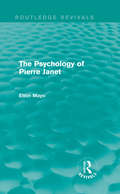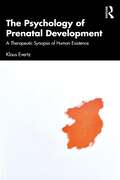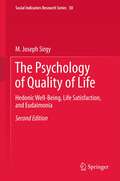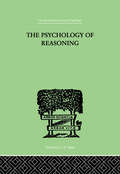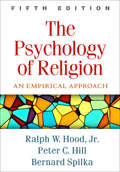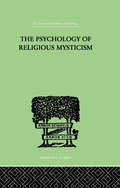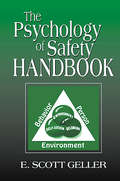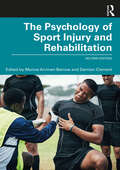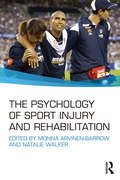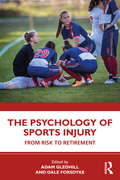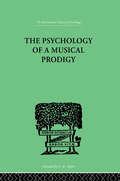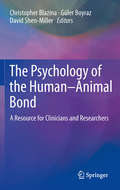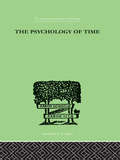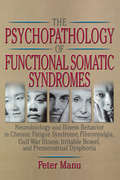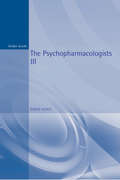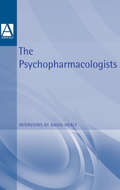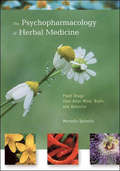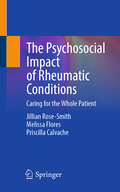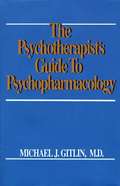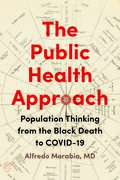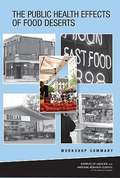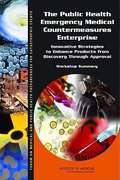- Table View
- List View
The Psychology of Pierre Janet (Routledge Revivals)
by Elton MayoPierre Janet (1859 – 1947) is considered to be one of the founders of psychology, and pioneered research in the disciplines of psychology, philosophy and psychotherapy. Janet’s most crucial research, particularly in the subjects of ‘dissociation’ and ‘subconscious’ - terms coined by him - is explored in this book, first published in 1952. As Janet did not publish much in English, these notes provide guidance on such areas of study as hysteria and hypnosis, obsessive thinking and the psychology of adaption. Elton Mayo’s comprehensive collection is an important guide for any student with an interest in the history of psychology, psychopathology and social study, and Janet’s revolutionary work in the field.
The Psychology of Prenatal Development: A Therapeutic Synopsis of Human Existence
by Klaus EvertzThis important book introduces the basics of prenatal psychology and works through the current scientific findings in the psychology and psychosomatics of pregnancy and birth. Through exploring bio-psycho-social relationships, as well as historical and cultural perspectives, this interdisciplinary approach easily breaks down specialist discussions into easy-to-understand concepts.Bridging the gap between foetal programming and psychological research and practice, this accessible book presents the history of the field and the basic concepts of prenatal development before exploring the behavioural dimensions of life before, during, and immediately after birth. Topics include sensory and emotional development in the womb, perception and brain development, the influence of environmental factors and prenatal imprinting and long-term effects. The author also delves into the concept of attachment and support and analyses body symptoms, sensations, feelings and inner images in dreams and imaginations, through the role of art creations and biographical narratives. As a whole, this book provides a therapeutic synopsis of the entire existence, which begins with conception.Explaining how experiences in the prenatal period influence basic psychological imprints across the lifespan, this book is an essential resource for students in a wide range of interrelated disciplines, including developmental psychology, paediatric medicine, neuroscience, infancy and early child development, nursing, social work and early childhood education. It may also be of interest to researchers, clinicians and related professionals.
The Psychology of Quality of Life
by M. Joseph SirgyThe second edition will be an update and further elaboration of the literature related to subjective well-being, happiness, and life satisfaction. It will have a new substantial section that focuses on reviewing much of the literature of subjective well-being within specific life domains (social life, material life, leisure life, work life, community life, spiritual life, family life, health life, sex life, travel life, etc.) In the 1st edition the research in these various life domains was discussed only briefly. The second edition will maintain the same organizational structure of the first edition; that is, Part 1 will focus on introduction (definitions and distinctions; examples of measures of subjective well-being, happiness, and life satisfaction; and motives underlying subjective well-being). Part 2 will focus on psychological strategies that are allow people to optimize subjective well-being by engaging in psychological processes related to the relationship between and among life domains (e.g., social life, family life, love life, spiritual life, community life, financial life, etc.) This part will contain four chapters related to these various "inter-domain" processes: bottom-up spillover, top-down spillover, horizontal spillover, and compensation. Part 3 of the book will focus on "intra-domain" psychological strategies designed to optimize subjective well-being. These include re-evaluation based on personal history, re-evaluation based on self-concept, re-evaluation based on social comparison, goal selection, goal implementation and attainment, and re-appraisal. Part 4 of the book will focus on balance processes--how people attempt to create balance in their lives using psychological processes within specific life domains (intra-domain strategies) and processes that relate one domain to another (inter-domain strategies).
The Psychology of Quality of Life: Wellbeing and Positive Mental Health (Social Indicators Research Series #83)
by M. Joseph SirgyThe third, thoroughly revised and enhanced edition of this bestselling book analyses and discusses the most up-to-date research on the psychology of quality of life. The book is divided into six parts. The introductory part lays the philosophical and academic foundation of much of the research on wellbeing and positive mental health, showing the beneficial effects of happy people at work, health, and to society at large. Part 2 (effects of objective reality) describes how sociocultural factors, income factors, other demographic factors, and biological and health conditions affect wellbeing and positive mental health. Part 3 focuses on subjective reality and discusses how individuals process information from their objective environment, and how they manipulate this information that affects wellbeing and positive mental health. Part 4 focuses on the psychology of quality of life specific to life domains, while Part 5 reviews the research on special populations: children, women, the elderly, but also the disabled, drug addicts, prostitutes, emergency personnel, immigrants, teachers, and caregivers. The final part of the book focuses on theories and models of wellbeing and positive mental health that integrate and unify disparate concepts and programs of research. The book addresses the importance of the psychology of quality of life in the context of public policy and calls for a broadening of the approach in happiness research to incorporate other aspects of quality of life at the group, community, and societal levels. It is of topical interest to academics, students and researchers of quality of life, well-being research, happiness studies, psychotherapy, and social policy.
The Psychology of Reasoning (International Library Of Psychology Ser.)
by Rignano, EugenioFirst Published in 1999. Routledge is an imprint of Taylor & Francis, an informa company.
The Psychology of Religion, Fifth Edition: An Empirical Approach (Archive For The Psychology Of Religion/ Archiv Fur Religionspsychologie Ser. #Vol. 27)
by Bernard Spilka Ralph W. Hood Jr. Peter C. HillKeeping up with the rapidly growing research base, the leading graduate-level psychology of religion text is now in a fully updated fifth edition. It takes a balanced, empirically driven approach to understanding the role of religion in individual functioning and social behavior. Integrating research on numerous different faith traditions, the book addresses the quest for meaning; links between religion and biology; religious thought, belief, and behavior across the lifespan; experiential dimensions of religion and spirituality; the social psychology of religious organizations; and connections to coping, adjustment, and mental disorder. Chapter-opening quotations and topical research boxes enhance the readability of this highly instructive text. New to This Edition *New topics: cognitive science of religion; religion and violence; and groups that advocate terrorist tactics. *The latest empirical findings, including hundreds of new references. *Expanded discussion of atheism and varieties of nonbelief. *More research on religions outside the Judeo-Christian tradition, particularly Islam. *State-of-the-art research methods, including techniques for assessing neurological states.
The Psychology of Religious Mysticism
by James H. LeubaFirst Published in 1999. Routledge is an imprint of Taylor & Francis, an informa company.
The Psychology of Safety Handbook
by E. Scott GellerYou cannot improve your organization's safety performance to enviable levels without addressing human behavior and attitude effectively. The only comprehensive reference on the psychology of the human dynamics of safety, The Psychology of Safety Handbook shows you how to apply psychology to improve safety and health in your organization. Dr. Geller
The Psychology of Sport Injury and Rehabilitation
by Monna Arvinen-Barrow Damien ClementWritten by internationally known experts The Psychology of Sport Injury and Rehabilitation draws on the latest research in sport psychology and sports medicine. Using case studies to augment the reader’s experience, this new edition emphasizes the importance of a holistic, interprofessional approach to sport injury management and care. By doing so, the book provides injured individuals, their families, and healthcare professionals a thorough overview of how psychology plays a role in sport injury prevention, rehabilitation, and return to participation process. Athletes routinely use psychological skills and interventions for performance enhancement but, perhaps surprisingly, not always to assist in recovery from injury. This book demonstrates the ways in which athletes and practitioners can transfer psychological skills to an injury and rehabilitation setting to enhance recovery and the well-being of the athlete. Psychology of injury is an integral part of sport injury prevention, rehabilitation, and return to participation process. The second edition of The Psychology of Sport Injury and Rehabilitation is a comprehensive text grounded in biopsychosocial theory and scientific evidence. The fully revised second edition is an important resource for students, academic scholars, and applied practitioners working in sport psychology, sports medicine, sports coaching, and other related healthcare professions.
The Psychology of Sport Injury and Rehabilitation
by Monna Arvinen-Barrow Natalie WalkerAthletes routinely use psychological skills and interventions for performance enhancement but, perhaps surprisingly, not always to assist in recovery from injury. This book demonstrates the ways in which athletes and practitioners can transfer psychological skills to an injury and rehabilitation setting, to enhance recovery and the well-being of the athlete. Drawing on the very latest research in sport and exercise psychology, this book explores key psychological concepts relating to injury, explaining typical psychological responses to injury and psychological aspects of rehabilitation. Using case studies in every chapter to highlight the day-to-day reality of working with injured athletes, it introduces a series of practical interventions, skills and techniques, underpinned by an evidence-base, with a full explanation of how each might affect an athlete's recovery from injury. The Psychology of Sport Injury and Rehabilitation emphasises the importance of an holistic, multi-disciplinary approach to sports injury and rehabilitation. No other book examines the psychological aspects of both sports injury and the rehabilitation process, and therefore this is an essential resource for students, scholars and practitioners working in sport psychology, sports therapy, sports medicine or coaching.
The Psychology of Sports Injury: From Risk to Retirement
by Adam Gledhill Dale ForsdykeThe Psychology of Sports Injury: From Risk to Retirement provides a critical overview of the psychology of sports injury, covering the 5Rs of sports injury: risk, response, rehabilitation, return to sport and retirement. Drawing on a range of expert international perspectives from the fields of sport psychology and sport and exercise medicine, The Psychology of Sports Injury covers the psychological considerations associated with sports injuries, prior to the onset of injury through to supporting athletes with post-injury retirement. In addition to this injury lifespan perspective, the book features special interest topics including anterior cruciate ligament injury, sport-related concussion, spinal cord injury and the role of coaches in achieving athlete and team medical outcomes. Additionally, case studies provide the opportunity to apply learning from each chapter. By covering the sports injury journey from risk factors to retirement and including athlete mental health during sports injury, The Psychology of Sports Injury is an essential text for students, instructors, and practitioners in sports psychology, sport and exercise medicine and other related fields.
The Psychology of Thinking about the Future
by Gabriele Oettingen Peter M. Gollwitzer A. Timur SevincerWhy do people spend so much time thinking about the future, imagining scenarios that may never occur, and making (often unrealistic) predictions ? This volume brings together leading researchers from multiple psychological subdisciplines to explore the central role of future-thinking in human behavior across the lifespan. It presents cutting-edge work on the mechanisms involved in visualizing, predicting, and planning for the future. Implications are explored for such important domains as well-being and mental health, academic and job performance, ethical decision making, and financial behavior. Throughout, chapters highlight effective self-regulation strategies that help people pursue and realize their short- and long-term goals.
The Psychology of Vaccination (The Psychology of Everything)
by Vincent Yzerbyt Olivier KleinWhy do some people choose to be vaccinated and others do not? What is the difference between vaccine hesitancy and anti-vaccinism? What can social psychology tell us about attitudes towards vaccination?The Psychology of Vaccination identifies the social psychological drivers of vaccine mindsets, to explore why some people choose to be vaccinated, some are hesitant, and others refuse. It explores the socio-demographic factors related to vaccine hesitancy and considers the role of motivation in making this health decision. The book focuses on how individuals are social beings, inserted into a web of influences that guide their behaviour, and considers the impact this may have on their health choices.Not only aimed at the convinced, but also for all those who have doubts about vaccination, The Psychology of Vaccination offers an insightful look at our health behaviours and considers whether it is possible to affect health behaviour change.
The Psychology of a Musical Prodigy (International Library Of Psychology Ser.)
by Revesz, GFirst published in 1999. Routledge is an imprint of Taylor & Francis, an informa company.
The Psychology of the Human-Animal Bond
by Güler Boyra Christopher Blazina David Shen-MillerThere have been dramatic increases in the financial, emotional, and psychological investment in pets over the past four decades. The increasing importance of animal companions in people's lives has resulted in growing emphasis on the human-animal bond within academic literature. This book introduces practicing and emerging professionals to vital subject matter concerning this growing specialty area by providing an essential framework and information through which to consider the unique contextual backdrop of the human-animal bond. Such contexts include a wide array of themes including: issues of attachment and loss, success and frustration with making and sustaining connections, world views regarding animal ethics, familial history of neglect or abuse, and cultural dynamics that speak to the order of things between mankind and nature. Adopting a contextual stance will aid mental health professionals in appreciating why and how this connection has become a significant part of everyday life for many. As with any other important clinical dynamic, training and preparation are needed to gain competence for professional practice and research. To this end, an ensemble of international experts across the fields of psychology and mental health explore topics that will help both new and established clinicians increase and understanding of the various ways the human-animal bond manifests itself. Perspectives from beyond the scope of psychology and mental health such as anthropology, philosophy, literature, religion, and history are included to provide a sampling of the significant contexts in which the human-animal bond is established. What brings these divergent topics together in a meaningful way is their relevance and centrality to the contextual bonds that underlie the human-animal connection. This text will be a valuable resource that provides opportunities to deepen one's expertise in understanding the psychology of the human-animal bond.
The Psychology of time (International Library Of Psychology Ser.)
by Sturt, MaryFirst Published in 1999. Routledge is an imprint of Taylor & Francis, an informa company.
The Psychopathology of Functional Somatic Syndromes: Neurobiology and Illness Behavior in Chronic Fatigue Syndrome, Fibromyalgia, Gulf War Illness, Irrit
by Peter Manu Roberto Patarca-MonteroLearn how a patient&’s behavior can factor into the prognosis of medically unexplainable illness! The Psychopathology of Functional Somatic Syndromes examines the link between mental illness and physical syndromes that lack organic disease explanations, including chronic fatigue syndrome, fibromyalgia, premenstrual dysphoria, irritable bowel, and Gulf War illness. The author has evaluated the best research work of the past 20 years to determine the association between psychopathology and functional illness, the biological gradient between somatic and psychological symptoms, and the manifestations of dysfunctional coping. The Psychopathology of Functional Somatic Syndromes challenges recent conceptualizations of functional somatic syndromes as brain disorders connected to affective spectrum disorder, serotonin deficiency, cerebral hypoperfusion or abnormal hypothalamic-pituitary-adrenal function and highlights the importance of abnormal illness behavior, sexual victimization, and maladaptive coping for the production and maintenance of these disorders. The Psychopathology of Functional Somatic Syndromes explores observations on the neurobiology and the personality abnormalities of patients made from structured data collected over a period of several years. It describes modern perceptions of functional somatic syndromes and how they have evolved into a tightly knit family of self-standing syndromes with a common core. The book examines the correlation between the burden of psychopathology and the physical features of these illnesses; reviews advances made in the appraisal of the neuroanatomy, neuropsychology, and neurochemistry of functional syndromes; and focuses on the connection between measurable dimensions of personality, coping, and illness behavior and the prognosis of medically unexplainable illnesses. The Psychopathology of Functional Somatic Syndromes examines: psychiatric morbidity brain perfusion post-traumatic stress in Gulf War illness the spectrum of mood disorders the hypothalamatic-pituitary-adrenal axis the sexual victimization of patients and much more! The Psychopathology of Functional Somatic Syndromes is an essential resource for psychiatrists and psychologists working in outpatient practice.
The Psychopharmacologists 3
by David HealyThe Psychopharmacologists 3 completes a trio of interview-based books about the process of therapeutic innovation in clinical psychiatry. David Healy's method is to interview key individuals involved in the discovery and deployment of drugs that have proved useful to psychiatry, and to draw them together within a model of the mechanism and clinical discovery that he uses as an overall framework.These are historical accounts but highly relevant to the clinical psychiatrist of today, emphasising the importance of research, and of the marketing strategies of pharmaceutical companies in formulating disease entities as well as treatments for them.
The Psychopharmacologists: Interviews by David Healey
by David HealyCreate! is a Design and Technology course for Key Stage 3. It provides all the material needed to deliver the demands of the new Key Stage 3 strategy. The course follows the QCA scheme and the materials support ICT requirements. A wide range of differentiated worksheets is available on a customisable CD-ROM. The student books contain clear links to the Key Stage 3 strategy and include design-and-make assignments, product evaluations and practical tasks; each spread opens with objectives to focus the lesson, and ends with a plenary to summarise and evaluate.
The Psychopharmacology of Herbal Medicine: Plant Drugs That Alter Mind, Brain, and Behavior
by Marcello SpinellaA compilation of current scientific knowledge about psychoactive herbal drugs.Virtually all cultures consume drugs from psychoactive plants. Caffeine, for example, is probably the most common stimulant in the world, and many modern medicines, such as morphine and codeine, are derived from plant sources. In these cases, scientific research has revealed the composition of the plants and how they interact with the nervous system. There are also many herbal medications with reputed therapeutic value that have not yet gained acceptance into mainstream medicine, partly because there has not been enough research to support their usefulness. Instead they are regarded as "alternative medicines." This is an active research area, however, and many current studies are focusing on identifying the active components, pharmacological properties, physiological effects, and clinical efficacy of herbal medicines. This book compiles and integrates the most up-to-date information on the major psychoactive herbal medicines—that is, herbal medicines that alter mind, brain, and behavior. It focuses particularly on the effects on various areas of cognition, including attention, learning, and memory. The book covers all major classes of psychoactive drugs, including stimulants, cognitive enhancers, sedatives and anxiolytics, psychotherapeutic herbs, analgesics and anesthetic plants, hallucinogens, and cannabis.
The Psychosocial Impact of Rheumatic Conditions: Caring for the Whole Patient
by Melissa Flores Jillian Rose-Smith Priscilla CalvacheThis book focuses on a holistic approach to providing care to patients with rheumatic illnesses that goes beyond the biomedical approach to include the psycho-social and cultural needs of patients. A diagnosis of a chronic rheumatic illness can dramatically affect all aspects of a person&’s life. These life-altering conditions are characterized by physical pain and inflammation that may reduce or impair functioning of one or more parts of the musculoskeletal system and in some cases impact other organs throughout the body. Often accompanying these physical manifestations of the rheumatic illness are the psychological and social aspects that affect one&’s overall health and quality of life. Due to the chronicity of many rheumatic illnesses, managing and coping with the illness is often an ever-evolving process that can span throughout the developmental spectrum or lifespan of the patient experience. A strictly biomedical approach to the treatment of rheumatic illnesses often fails to address these key aspects of the patients' overall well-being. A more comprehensive approach, inclusive of the bio-psycho-social-cultural lens, with the patient&’s voice at its core, is needed to inform and ultimately deliver quality patient care and achieve optimal health outcomes. This book serves as s a tool for the entire interdisciplinary rheumatology health care team. This comprehensive approach is framed within the context of well-documented health disparities in rheumatology with a focus on psycho, social, emotional and environmental aspects of health that contribute to patient quality of life. It explores the needs of special populations and provide opportunities for clinicians to consider how to treat diverse populations in a more inclusive way. At the center of this book is the patient&’s voice utilizing patient stories to provide the reader with real life examples that reflect the life cycle of rheumatology patients and the impact of key interventions or lack thereof that can impact the patient experience. Lastly, offers practical, evidence-based strategies for members of the rheumatology health care team. These tools can be integrated in their assessment and treatment plans for patients and their loved ones. This holistic approach can help to foster effective communication, build trust, enhance partnerships and amplify the patient voice to optimize health outcomes and enhance overall well-being.
The Psychotherapist’s Guide to Psychopharmacology
by Michael J. GitlinGitlin (psychiatry, UCLA) provides a guide to medicines used for treating mental and emotional disorders, designed to familiarize mental health professionals who do not prescribe medicine with the latest medical treatment options. He describes the type of treatment used for numerous disorders, explaining in detail how each medication works and its effects.
The Public Health Effects of Food Deserts: Workshop Summary
by Institute of Medicine National Research Council of the National AcademiesThis report from the January 2009 workshop examines neighborhoods and communities that have limited access to affordable and nutritious foods, and describes several approaches to measuring food deserts and their impact on public health. Researchers from the US and Britain evaluate different interventions to ameliorate food desert conditions and identify current research gaps and needs. No index is provided. Annotation ©2010 Book News, Inc. , Portland, OR (booknews. com)
The Public Health Emergency Medical Countermeasures Enterprise: Innovative Strategies to Enhance Products from Discovery through Approval
by Institute of Medicine of the National AcademiesDuring public health emergencies such as pandemic influenza outbreaks or terrorist attacks, effective vaccines, drugs, diagnostics, and other medical countermeasures are essential to protecting national security and the public's well-being. The Public Health Emergency Medical Countermeasures Enterprise (PHEMCE)--a partnership among federal, state, and local governments; industry; and academia--is at the forefront of the effort to develop and manufacture these countermeasures. However, despite the PHEMCE's many successes, there are still serious challenges to overcome. Government-funded medical research is not always focused on countermeasures for the most serious potential threats, and it is difficult to engage pharmaceutical and biotechnology companies to develop and manufacture medical countermeasures that have a limited commercial market. At the request of the Secretary of the U.S. Department of Health and Human Services and the Assistant Secretary for Preparedness and Response, the IOM held a workshop February 22-24, 2010, to address challenges facing the PHEMCE. Workshop participants discussed federal policies and procedures affecting the research, development, and approval of medical countermeasures and explored opportunities to improve the process and protect Americans' safety and health.
